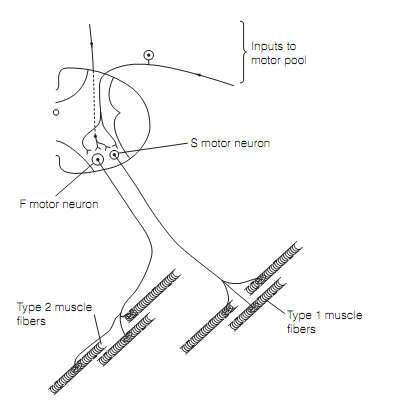Motor pools
Motor neurons which innervate the similar muscle form a general motor pool. Motor pools are topographically localized in motor nuclei of the brainstem and spinal cord. Spinal motor nuclei expand over numerous spinal segments. The axons of motor neurons leave ventral horn of the spinal cord to run in the spinal nerve of similar spinal segment. The sorting of fibers destined for similar muscle however originating from different spinal segment takes place in the nerve plexuses. The axon collaterals of motor neurons ascend and descend a few segments to influence the behavior of other motor neurons in the same pool.
The force of contraction of a muscle is determined by the motor pool in two ways; the rate at which individual motor neurons fire and the number of motor neurons in the pool which are firing. Small increases in force are met frequently by increased firing rate, but larger contractions include increasing the number of active motor units, a process known as recruitment. This is completed in an orderly manner. In common, the earliest units to be recruited are S, followed by FR and lastly FF, an order determined by the size principle. Two effects are at work here. First of all, the size of the motor neurons, and secondly how synapses onto them are organized.
How does size of a motor neuron determine the size principle. Small cells recommend a bigger resistance to the flow of current than large ones. The Ohm’s law says that the relationship between the membrane voltage, V, and current, I, flowing into a cell is given as follows:
V = IR
This means that a given current will generate a greater change in membrane voltage in a small cell (i.e., with large R) than it will in a big cell (i.e., with small R). Neurons in a motor pool are excited by general inputs. For a given sized synaptic current input into cells in the pool, the small cell body of S motor neuron will have a bigger excitatory postsynaptic potential than the larger cell body of a rapid twitch unit, as the S cell has the greater resistance as shown in figure. This means that the weakest inputs recruit the S units, since they have the lowest threshold for synaptic activation. As the inputs to the pool get gradually stronger the other motor neurons are excited in turn.

Figure: The size principle in recruitment. The smaller slow twitch (S) motor neurons are recruited before rapid twitch (F) motor neurons as they have a bigger excitatory postsynaptic potential in response to a given input.
The second effect determining the size principle is that the synaptic inputs to the three classes of motor unit are weighted in such a manner that as input strength increases therefore motor units are recruited in the series S–FR–FF. Though, recruitment does not always obey the size principle. In few instances synapses are arranged so that large motor neurons acquire more excitation than small ones. For illustration, in humans, cutaneous afferents preferentially excite fast twitch motor units.
Motor neurons are modulated by monoaminergic neurons (NA, 5-HT) which project in the reticulospinal tracts. This enhances the response of the motor neurons to excitatory (glutamatergic) input. For illustration, generally S motor units fire tonically at 20–30 Hz, although with elevated monoamine input Ia afferents will generate firing rates in excess of 50 Hz. The firing rate of mono-aminergic neurons increases with arousal therefore the modulation by NA permits the generation of higher forces from similar input whenever arousal is high, like “fight or flight” cases. The serotonin neurons fire through locomotion and their firing rate increases with the speed of locomotion, driving motor neurons to fire at high frequency for a given excitatory input than they or else would. Monoamines bring about motor neuron hyper-excitability mostly by the enhancement of a depolarizing current via L-type calcium channels in their dendrites.